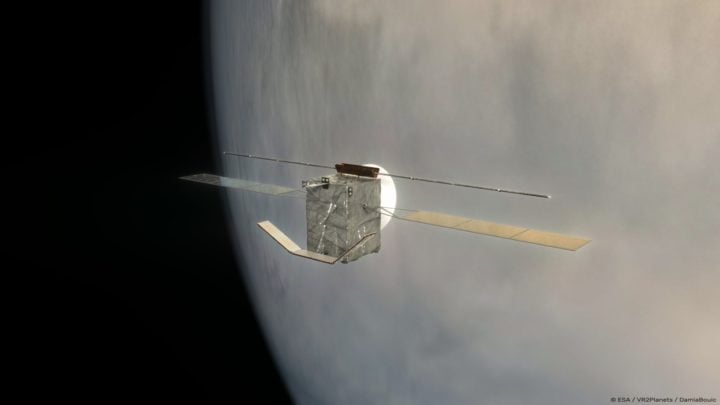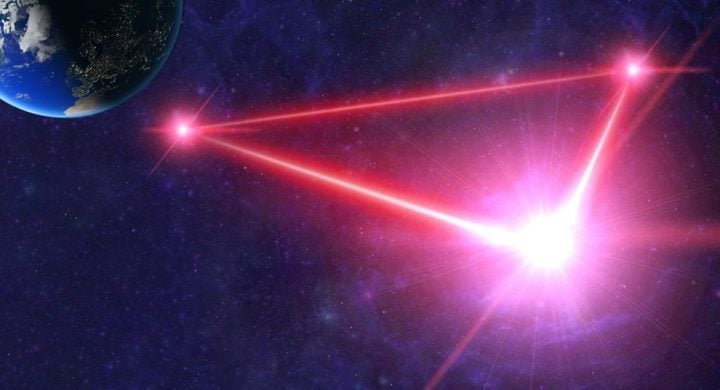On 25 January 2024, the L-class Laser Interferometer Space Antenna (LISA) flagship mission and the M-class EnVision mission cleared another important hurdle in the European Space Agency’s (ESA) Science Programme.

Venus is Earth’s inner neighbouring planet. It orbits the Sun at a distance of just over 100 million kilometres. The planet has a dense atmosphere of carbon dioxide, which generates more than 90 times the pressure on the surface than on Earth, which is roughly equivalent to the water pressure at a depth of 900 metres on Earth. At altitudes between around 30 and 60 kilometres, there are layers of haze and clouds of sulphuric acid that make it impossible to see the surface of the planet directly. Investigating the composition and dynamics of Venus’ atmosphere is one of the focal points of ESA’s EnVision mission (artist’s impression). Image credit: ESA/VR2Planets/Damia Bouic
ESA’s Science Programme Committee has formally transferred the LISA observatory for detecting gravitational waves and the EnVision mission to explore Venus into their implementation phases by means of ‘mission adoptions’. This means that the detailed design, construction and, later, the extensive testing of the spacecraft, payloads and ground infrastructure can begin in full.
The German Space Agency at the German Aerospace Center (Deutsches Zentrum für Luft- und Raumfahrt; DLR) is the largest contributor to ESA’s science programme and, therefore, provides significant financial support to the LISA mission and parts of EnVision.
This means that important parts of these two major European space projects are being realised in Germany. DLR in Berlin is significantly involved in one of the main instruments for EnVision. The DLR Institute of Planetary Research is responsible for managing and coordinating the entire VenSpec suite.
The DLR Institute of Optical Sensor Systems is developing and constructing this multispectral camera to search for active volcanoes and map the surface mineralogy.

LISA – Detecting oscillations in spacetime: The LISA observatory will detect low-frequency gravitational waves from space and determine the nature of their sources with great accuracy once it goes into operation at the end of 2035. Gravitational waves — oscillations in space-time — are caused by the rapid acceleration of incredibly massive objects, such as the merging of two stellar-mass or supermassive black holes. The tiny amplitudes of a gravitational wave can only be detected by highly sensitive laser interferometry. In LISA, this laser interferometer is created by three identical probes that form an almost equilateral triangle with sides measuring around 2.5 million kilometres. This will make LISA by far the largest observatory ever built. Image Credit: NASA/JPL-Caltech / NASA / ESA / CXC / STScl / GSFCSVS / S.Barke (CC BY 4.0)
LISA – detecting waves in spacetime
LISA was selected as one of the three major flagship missions in ESA’s Science Programme back in 2017. Since then, intensive work has been carried out on the technical concept and its implementation. The scientific preparations that have been underway since the 1990s, including the extremely complex data processing and analysis, have also been intensively continued by a global consortium of more than 1500 researchers.
ESA, as well as the participating national institutions from various European countries and NASA in the USA and their industrial contractors, will now significantly increase the size of their teams in order to carry out the extensive development work that is still required before the planned launch of the mission in mid-2035.
Once it is operational in space from the end of 2035, LISA will detect low-frequency gravitational waves and accurately determine the nature of their sources. Gravitational waves — oscillations in spacetime — are caused by the rapid acceleration of incredibly massive objects, such as the merging of two stellar-mass or supermassive black holes.
The tiny amplitudes of a gravitational wave can only be detected by highly sensitive laser interferometry. In LISA, this laser interferometer is created by three spacecraft that form an almost equilateral triangle with sides that are approximately 2.5 million kilometres in length. This will make LISA by far the largest observatory ever constructed.
LISA – the largest observatory is being developed and built with a significant German contribution
LISA is being developed and built as part of ESA’s Science Programme with the participation of NASA and with contributions to the payload from more than ten European countries, including Germany. ESA’s industrial prime contractor for the overall mission will be selected in 2025 among a German and a German-Italian industrial consortium – Airbus in Friedrichshafen and OHB in Bremen and Oberpfaffenhofen together with Thales-Alenia in Italy.
A scientific consortium is substantially involved in the development of LISA and is also setting up the mission’s data processing and archiving. The German contribution to the mission is of decisive and mission-critical importance. This extensive contribution to LISA is largely attributable to the leading role of the Max Planck Institute for Gravitational Physics / Albert Einstein Institute (AEI) in Hanover in the development of the Interferometric Detection System (IDS), the components of which are provided by various partners in Europe.
The core of the IDS, developed by the AEI, is the central ‘phase meter’ of the mission alongside the optical system, which is to be supplied by a partner from the UK. There is close cooperation with the Technical University of Denmark (DTU) in Copenhagen. In addition, the institute in Hanover will supply a vital mechanism for the payload in collaboration with Dutch partners.
The AEI is also supporting the mission and ESA with many system design issues, drawing on its extensive experience from the development and operation of the LISA Pathfinder technology demonstrator. This precursor mission successfully tested the key measurement principles for LISA in space from 2015 to 2017.
Together with the German space industry, the AEI also played a leading role in this mission. The entire participation of the AEI in LISA, one of whose personnel is also the scientific lead (Principal Investigator) of the gravitational wave mission, is significantly supported by grants from the German Space Agency at DLR with funds from the Federal Ministry for Economic Affairs and Climate Action (BMWK).
EnVision – a multifaceted mission to Venus
You can offer your link to a page which is relevant to the topic of this post.

